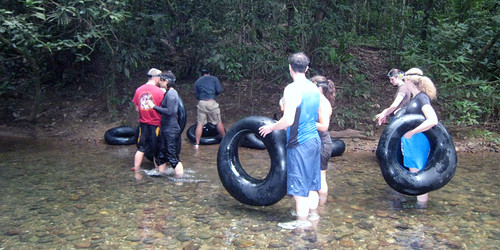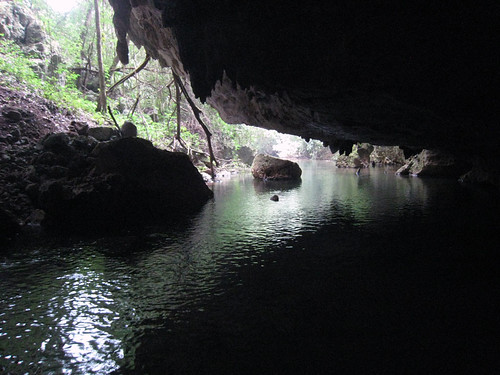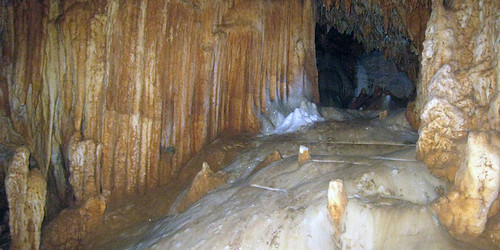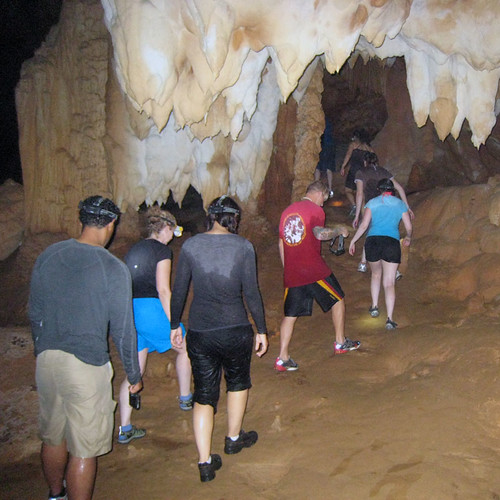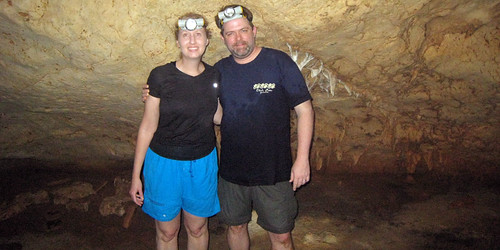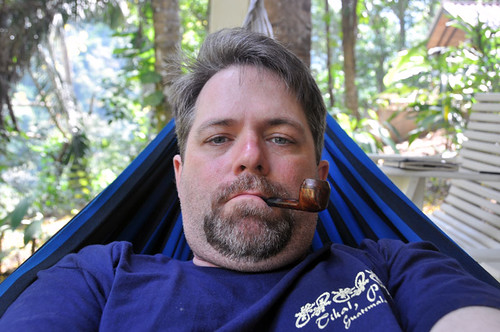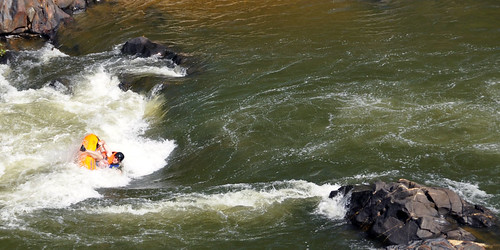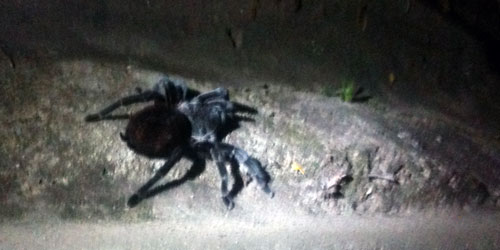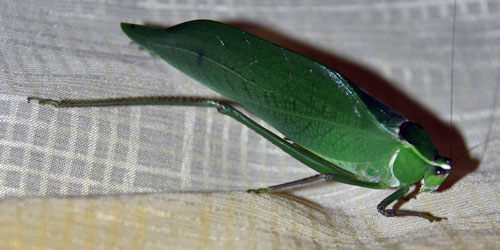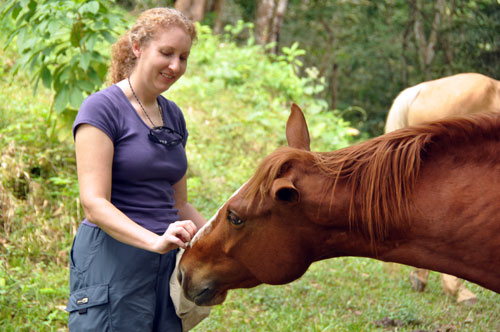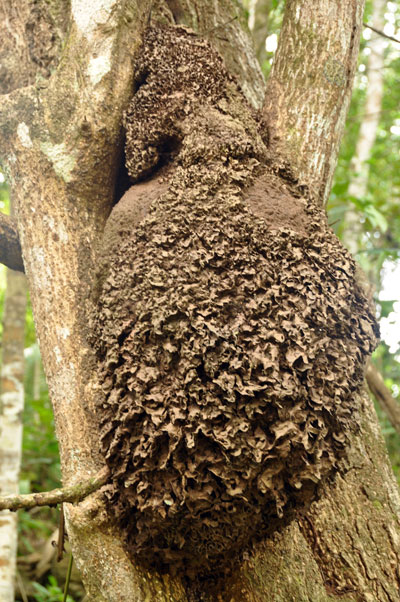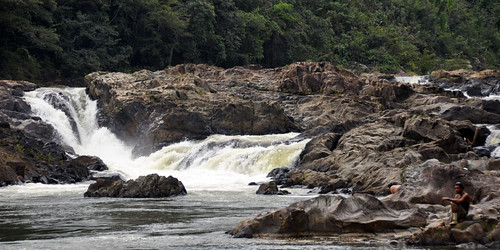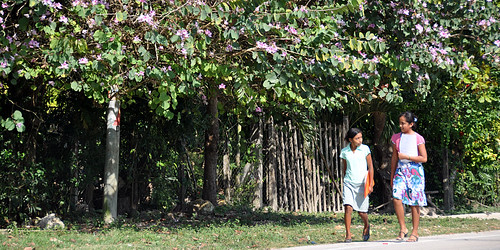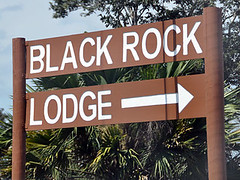We rose early on Monday to leave for Guatemala and the Mayan ruins known as Tikal. After a short van ride to the border between the two countries, we were out of Belize and in another world.
Though similar to Belize in many ways, Guatemala featured some key differences. Belize is laid back. As soon as we crossed the border, things seemed more tense: Armed guards with heavy-duty shotguns, and so on. Also, English is the primary language in Belize; in Guatemala, it’s Spanish. But mostly, the two countries seemed more similar than different.
Here’s a little roadside shack typical of the stores we saw in Guatemala and Belize. There are tons of these little buildings, from which people sell soda and snacks.
Some folks sell from carts. I asked one tour guide if they needed permits to sell from their stands and carts. “Yes, of course,” he said.
And here are a couple of Guatemalan houses, which are similar to the homes we saw in Belize. I actually think these homes are larger than most of those we saw. These have two stories, and the one on the left has a thatched addition in the rear. Many of the homes we saw were only the size of a single floor (so, a few hundred square feet maybe).
Most homes have clothes lines with laundry hung out to dry. Many also have bikes and tools left in the open and animals in the yard, few of which restrained. In Belize and Guatemala, animals roam free. Most livestock is tied up or fenced, but that’s not always the case. Dogs are unleashed and walk along the side of the road just like the people. (They seem to have their own dog agendas.)
We saw goats and chickens and horses loose, too, though I suspect the horses weren’t meant to be out. And in Guatemala, we saw pigs. Lots of pigs, many of them just trotting on the roadside to who knows where:
When we finally reached Tikal at about 10am, it was already hot.
Tikal
Tikal was once a major city, the heart of the Mayan world. Its oldest buildings were constructed over 2500 years ago, and temples and structures were gradually added over a period of more than 1000 years. Eventually, Tikal fell into disuse (as rival Mayan cities assaulted it), was abandoned, and fell out of memory. In time, the jungle took over and buried the ruins.
The site was re-discovered in 1848, and restoration began in the 1950s. Now several temples are open and available for public viewing, while other structures are slowly being restored.
Our group was led by Ronny, the very earnest Guatemalan tour guide. His speech was labored as he searched to find the right English words. Sometimes he gave up and used Spanish. (Later I learned that his English is entirely self-taught!)
Ronny wasn’t popular with the group, who wanted somebody who was more fluent in English. But I liked him. He was obviously proud of his Mayan heritage and the Guatemalan culture. He tried hard, and I was glad to have him with us.
Ronny only gradually introduced us to Tikal. First he led us down a long avenue of trees. He paused to give historical information (always searching for the right words). After maybe 30 minutes, he finally brought us to the back side of the awesome Temple I.
From the flyer I bought: “Also known by the name of the Great Jaguar Temple, it is the landmark of Guatemala to the world. It has a 45 meters high and it was build around the year 700 A.D. Underneath the temple, the tomb chamber of one of the most famous rulers at Tikal was built.” Ronny called this king the “chocolate ruler”.
We made our way around to the front of the temple and into the temple plaza.
The grand plaza was the core of Tikal, and was surrounded by Temple I in east, the Northern Acropolis in the north (surprise!), Temple II in the west, and the Central Acropolis in the south.
To get a better view, we climbed to the top of Temple II (“The Temple of Masks”), which is 38 meters high and was built for the wife of the “chocolate ruler”. From the top of Temple II, the view was amazing.
Note that part of the Northern Acropolis can be seen to the left of Temple I here. The Northern Acropolis and Central Acropolis were residential quarters for the nobles (or “no bless”, as Ronny called them). These areas also contained administrative offices and tombs.
At the top of Temple II, one of the others in our group (Leon from Saskatchewan) offered to take our photo. His snapshot cracks me up:
Thanks, Leon!
One of the great things about Tikal (and all of Guatemala and Belize) is that it hasn’t been taken over by lawyers. Tourists want to climb to the top of the temples, so the Guatemalans have built wooden stairs and ladders, most of which are very very steep. (In the photo below, Kris is descending some stairs that are only moderately steep compared to others we saw.) If you want to risk climbing, you climb. If you don’t, you don’t. As I’ve been saying all week, it really reminded me of the U.S. circa 1975. And I liked it.
As you can see, this would never be allowed in the U.S. today. Many of the things we saw and did would not have been possible in the U.S. because of safety regulations and legal concerns.
After we visited the grand plaza, we made our way to Temple V, which is one of the more recently restored temples. Here the steps were even steeper: an almost vertical ladder. But what I liked most was how during restoration, the experts decided to leave the back side of the temple as they’d found it.
“How could Tikal have been lost?” one of our group wondered early on. But after having seen it, I can understand. If the Mayan civilization here really had been routed by rival tribes, Tikal might have faded from memory after a couple of generations. And then the forest would have taken over, jungle vines consuming the buildings. When you see how the jungle clings to and covers the temples, you can see why it took so long to re-discover the city.
The highlight of the day was climbing to the top of Temple IV, which stands 70 meters above the jungle floor. Restoration on this temple has only just begun, so the bottom is still just a mound of earth and vegetation. But the view from the top was incredible:
Standing on top of Temple IV cannot be described, and pictures don’t do it justice. If only I’d thought to use my video camera, I might have captured some of the wonder.
The Mayans built Tikal on a highland, and Temple IV is on the highest point. It’s also the tallest building in the city, soaring above the jungle. It didn’t used to be surrounded by jungle, but by fertile plains. When constructed 1200 years ago, it commanded a view of the surrounding countryside, making invasion of Tikal difficult, if not impossible.
As we stood atop Temple IV, we baked. The sun was blistering, and the temple itself was like an oven, retaining the heat of the day. In addition to the usual jungle sounds, we could hear the distant roar of a troop of howler monkeys. (They sound like elephants!)
It was only once I’d climbed down from Temple IV that it dawned on me that I’d seen that view someplace before. In fact, I’d seen it many many times. “Omigod,” I said. “Do you know what that was? That was Yavin IV!”
“What are you talking about?” asked Kris.
“Yavin IV. The rebel base in Star Wars. That’s totally it,” I said. I was in a little fan-boy swoon. And I was right:
I know that’s going to seem crazy to many of you, but this really was one of the highlights of my life: To suddenly find myself in the world of Star Wars was incredible, and completely unexpected.
Hot hot hot
We knew before we left that we’d experience some hot and humid days:
But we just didn’t realize how hot and humid it would really feel. Though Monday’s forecast was for temperatures of 33 centigrade, it actually reached at least 37 while we were at Tikal (and may have gone higher!). It was very much like strolling through a sauna.
After spending three hours among the ruins and covering about four or five miles of walking, we finally took a break for lunch. We dined on chicken and onions with rice. I also had a lemon Crush (!!). I also gave in and ordered fresh lime juice, which was delicious.
Note: One of my favorite parts about traveling to other countries is exploring the food you can buy at stores and restaurants. When you travel to Canada or the U.K., for example, you get different flavors; blueberry is popular in both countries, but you almost never see blueberry stuff in the U.S.
I was hoping Belize would have some interesting foods, but almost everything was just as you’d find here. We did pick up some bacon-flavored potato chips (meh) and some complete seasoning, but nothing else really seemed exotic. The only real food highlight was the lemon Crush in Guatemala and the availability of many flavors of Fanta in Belize.
(By the way, pop still comes in glass bottles in Belize, and the bottles are recycled whole. I had a Coke bottle from 1994; the logo was rubbing off, but the bottle still worked, so they kept putting it back into circulation. Awesome!)
On the drive home, we passed a Guatemalan school with these psychedelic muppets painted on the side:
Driving in Guatemala was scarier than driving in Belize (and Belize was scary enough!). At one point on the drive home, for example, we encountered road construction. In the U.S., you’d have a whole crew of flaggers and systematic detours. Not here. Instead, the equipment had torn up the road completely, leaving only the steeply-sloped grassy shoulders. There was nobody to signal traffic. Vehicles had to take turns driving on the side of the road, moving slowly so as not to tip over. And, of course, the roadwork went right up to a bridge over a muddy river.
From what little I saw of it, I love the Guatemalan way of life. It seems so down to earth. It’s also pretty impoverished, I think, but the people are beautiful. I’d love to visit the country for a longer period of time.
Just after we crossed the border back into Belize, John stopped the van to pick up his girlfriend and his little daughter (the same daughter we’d waved to in San Ignacio when John drove us back from the airport on Saturday night). They’d been walking along the road, just like everyone else does in Belize, so John stopped to pick them up. We gave them a lift for a mile or so.
New friends
During the trip to and from Tikal, we chatted with Simon and Catherine from London, England. Catherine is a forensic toxicologist, so she and Kris could compare notes. Simon is in pharmaceuticals and helps organize the 2000 Trees rock festival. We really enjoyed their company over the next couple of days.
Back at the lodge, we continued to chat with Tim and Shana, the doctors from Philadelphia. At dinner, we were seated next to Eric and Viola from Connecticut.
One of the highlights of this trip was talking with the other travelers, especially the young couples. They were all amiable and fascinating. If they lived in Portland, we might count them among our friends. It’s also interesting to hear their travel experiences: Many of us have decided to make world travel a priority, and are willing to make sacrifices — no children, small homes, and so on — in order to make that happen.


